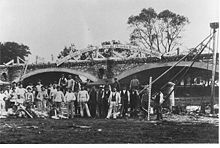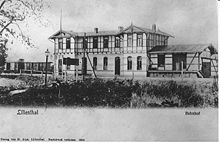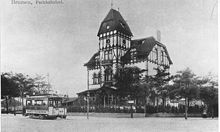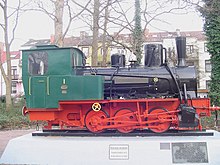Small train Bremen – Tarmstedt
| Small train Bremen – Tarmstedt | |||||||||||||||||||||||||||||||||||||||||||||||||||||||||||||||||||||||||||||||||||||||||||||
|---|---|---|---|---|---|---|---|---|---|---|---|---|---|---|---|---|---|---|---|---|---|---|---|---|---|---|---|---|---|---|---|---|---|---|---|---|---|---|---|---|---|---|---|---|---|---|---|---|---|---|---|---|---|---|---|---|---|---|---|---|---|---|---|---|---|---|---|---|---|---|---|---|---|---|---|---|---|---|---|---|---|---|---|---|---|---|---|---|---|---|---|---|---|
| Course book section (DB) : | ex 217e | ||||||||||||||||||||||||||||||||||||||||||||||||||||||||||||||||||||||||||||||||||||||||||||
| Route length: | 27.0 km | ||||||||||||||||||||||||||||||||||||||||||||||||||||||||||||||||||||||||||||||||||||||||||||
| Gauge : | 1000 mm ( meter gauge ) | ||||||||||||||||||||||||||||||||||||||||||||||||||||||||||||||||||||||||||||||||||||||||||||
| Top speed: | 30 km / h, for railcars 40 km / h | ||||||||||||||||||||||||||||||||||||||||||||||||||||||||||||||||||||||||||||||||||||||||||||
|
|||||||||||||||||||||||||||||||||||||||||||||||||||||||||||||||||||||||||||||||||||||||||||||
The Kleinbahn Bremen – Tarmstedt (which abbreviated itself Br.–T. ), popularly called "Jan Reiners", was a narrow-gauge railway line to develop the moorland north of Bremen . It was in operation from 1900 to 1956.
Situation before the railway construction
The moor areas north of Bremen are by nature an area hostile to traffic, which was only opened up in the 18th century by the work of the moor colonizer Jürgen Christian Findorff . The main line of business here was peat extraction , especially in the second half of the 19th century . Most of the fuel was brought to Bremen in small boats via the extensive canal network . The moor dwellers were also supplied with building materials and fertilizer in this way. A peat farmer needed two to three days to get to Bremen and back. In 1892 34,000 peat ships sailed through Lilienthal alone on the Wörpe .
Until the 1890s there were only railroad lines on the edge of the Elbe-Weser triangle . Also road connections were, especially in the bog, still very deficient.
planning
In October 1891 the Lilienthal agricultural association under its chairman Johann Reiners suggested building a railway through the moorland for the first time. Initially, a standard-gauge secondary railway was planned from Horn via Lilienthal, Zeven and Harsefeld to the Lower Elbe . The war ministry in Berlin , however, required a full-line design for a license so that military trains could also run over the railway. However, the higher construction costs for this could not be raised, so the route was rescheduled to a narrow-gauge small railway with 1,000 mm gauge.
Another important reason for the decision to design the 1000 mm track width was the unlimited loading times for goods that had to be handled in the bog due to the lack of roads at the individual stations (e.g. peat, wood, but also luxury goods ). (For comparison: the state railway calculated its costs according to the weight handled and the time it took to handle the goods, while the private railway company had unlimited time for the handling. Loading a freight car with peat could take up to eight days. The peat farmers owned only simple horse and carts with limited capacity for the handling of goods. A wagon load of peat cost 6, - Marks for Jan Reiners for the transport to Bremen, and the transporter received a free ticket ( Bremen parking station and back) from the railway company. The disadvantage was that the Freight wagons always had to be loaded and unloaded by the hauliers themselves. The State Railroad demanded a multiple of the freight premium for the provision of the respective freight wagons. This regularly led to overloading of the freight wagons and to recurring transport problems in private rail transport, including broken axles of the freight wagons and handling problems in the Loss adebahnhof Utbremen, as well as inevitable delays in freight and passenger traffic until it was discontinued in 1954.)
The planning was finally shortened to the Bremen - Tarmstedt section. Not only financial reasons were decisive for the route, but also disputes between the individual communities. In the shortened route, the route should be routed in the original version to Wilstedt . The Wilstedter municipal council refused on the grounds that they feared too high a number of strangers attending church on Sundays in their own church. When it was finally decided to build the line to Wilstedt, the decision about the route had already been made in Bremen for the Tarmstedt terminus.
An initially planned introduction to the Bremen – Hamburg line of the state railway in Horn was not possible as a narrow-gauge railway, so that a separate introduction of the small railway into the Bremen city center had to be built. For this purpose, the railway used the route used by the Wanne-Eickel – Hamburg line until 1891 on its way through the Findorff district . The terminus was built at the point where this line also had its provisional station, namely the place of today's town hall on the Bürgerweide , directly in front of the Bürgerpark . Hence the name Bremen Parkbahnhof for the terminus.
The small railway was built by the AG for railway construction and operation in Frankfurt am Main, which was founded especially for this purpose and which also took over the management. From 1929 it operated under the name of the German Railway Company . There was a joint local management with the Bremen-Thedinghauser Eisenbahn . The owner was the Bremisch-Hannoversche Kleinbahn AG (BHK), also Frankfurt am Main. The main line from Bremen Parkbahnhof to Tarmstedt went into operation on October 4, 1900. According to a document from the royal government in Stade dated June 21, 1898, a license was granted for the Prussian part for a period of 99 years. The Bremen Senate granted approval for the Bremen part of the route on July 22, 1898.
The locomotive of the inaugural train bore the name of the originator of the railway line, the Lilienthal-based economics councilor Johann Reiners (1825–1908), who had been very committed to the construction of this railway. The railway was then referred to colloquially as "Jan Reiners".
business
Operation was initially started with four locomotives from Hannoversche Maschinenbau AG Hanomag , eight passenger cars , two mail and baggage cars and 50 freight cars . The maximum speed was 30 km / h. Initially, three pairs of trains were offered on working days, on Sundays two additional pairs of trains were inserted for excursion traffic. The price for a single journey over the entire route was 1.10 marks. At first, mixed freight and passenger trains were offered. Since this type of operation proved to be susceptible to delays, freight and passenger traffic were completely separated after the First World War .
The excursion traffic was considerable, 4000 passengers were counted on the first Sunday after the opening of the company . Otherwise, passenger traffic also developed satisfactorily. In 1903 310,325 people took the train, in 1913 there were almost 500,000 and in 1921 even 529,000. In 1911, the Kleinbahn considered electrifying the line , but implementation was prevented by the outbreak of the First World War.
In freight transport, however, performance always fell short of expectations. This was mainly due to the fact that in the transfer station Utbremen all goods had to be reloaded onto the wagons of the state railway. There has never been roll-head traffic on the Kleinbahn because of the low load-bearing capacity of the track systems. Up to the First World War, the transport of goods increased continuously (to 45,000 t in 1913), after the onset of the First World War, then again until the end of the 20s, when the global economic crisis began. After that, the freight transport remained permanently below 20,000 t annually, with the exception of 1938 and 1939 due to the construction of the motorway (22,000 t).
In 1917, Tarmstedt was also made accessible by the Wilstedt-Zeven-Tostedter Railway (WZTE). The WZTE station was to the east of the “Jan Reiners” terminus. A 400 m long footpath was expected to change. It was not until 1934 that the Bremen – Tarmstedt small railway was extended by this piece to the new Tarmstedt Ost terminus at the request of many passengers . This extension piece was generally not used by the locomotive-driven trains of the railway, but only by the four railcars that were used on the small railroad from 1934, since there was no transfer option here.
These railcars gave the opportunity to significantly improve the timetable . The travel time was reduced by a total of 25 minutes, also due to the higher maximum speed of 40 km / h, and the timetable was condensed. Only the strong field morning and evening trains of rush hour were more than steam trains run.
The Kleinbahn was initially quite profitable, in 1918 a dividend of 6% could be distributed. The first problems arose when the reserves were destroyed by the inflationary years and necessary renewals could only be financed from current income. Already at the end of the 1920s, competition from motor transport became noticeable: The Bremer Vorortbahn acquired the bus concession for the Horn – Falkenberg route in 1926 and subsequently fought a price war with the small train.
During the Second World War , the route was damaged by air raids, and shortly before the end of the war the Wümmebrücke was partially blown up. There was a shuttle service on both sides of the bridge until September 1945, then continuous operation could be resumed. In addition, the railcar shed at Bremen Hemmstrasse station had been destroyed, causing all four railcar trailers to be lost.
With the increased volume of automobile traffic and parallel public transport lines, income fell. This put the Kleinbahn in a financially difficult position. In addition, the relatively light superstructure of the line would have had to be renovated and the outdated locomotive and wagon fleet replaced. The railway administration still had an extremely thin equity base. The Lower Saxony and Bremen state governments had completely canceled their subsidies for rail operations in the 1954 calendar year. Inevitably, the necessary investments could not be made by the railway administration. Due to the decline in freight traffic due to errors in reloading the freight at the Utbremen loading station , there were often delays that the Federal Railroad billed for the provision of their freight wagons. Delays due to constantly overloaded freight wagons were symptomatic, and the result was some broken axles. The number of passengers in passenger train traffic remained relatively constant and in 1950 had a record number of 776,000 passengers for the small railroad sector. In comparison, the Moorexpress carried over 20,000 people on the route Bremen Hbf - Worpswede - Bremervörde - Stade in 2007. Here, a resumption of regular passenger traffic, including on working days, is being considered.
The small train “Jan Reiners” was able to transport over 10,000 passengers in one weekend. This was made possible by the improvisational talent of the railway staff. Excursion trains of up to 20 wagons were put together, which were pulled by two steam locomotives and one steam locomotive pushed. The problem was the “Utbremen” incline in the area of the Bremer Bürgerpark / Stadtwald up to the level of the state railway and the incline in the area of the “Horner Rampe” approach over the bridge of the Reichsautobahn. Trips from the Bremen area to Bremer Freimarkt to Bremen Parkbahnhof , which directly adjoined the festival area, were legendary . The Bremen restaurateurs ordered the trains by telephone at short notice up to an hour before the departure of the desired trains, either from the railway staff at Bremen Hemmstrasse station or from the Bremen Parkbahnhof railway operations management . Trains were provided quite pragmatically as long as there was a need for passenger transport; if necessary until the early hours of the morning. The love of the people of Bremen for their “Jan Reiners” small train went so far that the freight wagons, which were provisionally converted for passenger excursions by the railway staff, were repainted by the citizens themselves in the Bremen state colors red and white. These wagons were in use until rail traffic was discontinued and were also referred to by the rural population as "Bremer Waggons" or "Bremer Wagen". The fuel, such as wood or coal, which was necessary to heat the stoves in the wagons in winter, was brought by the passengers themselves and the stoves were fired by the passengers themselves. The inventory of the wagons (cost of a replacement pane: 3 RM) occasionally broke during these journeys in the struggle for the best seats. The small train "Jan Reiners" was used intensively by the population for hamster rides in the moor areas in and between the two world wars. The gendarmerie regularly intervened against the passengers, usually women from Bremen, without any notable success. A police officer was evidently thrown from the train by the women during the inspection. The railway staff actively supported the smuggling operations of the Bremen population and provided some undetected cavities in the wagons. Pipe tobacco is also said to have ground the wheel rims of the locomotive into the finest tobacco.
After protests by some passengers and an urgent appeal by the railway board to the Bremen state government to take over the 20 unemployed employees of the "Bremisch-Hannoversche Kleinbahn" in the Bremen state service, the railway was stopped, initially on the Bremen-Falkenberg section. There was still no road connection from Falkenberg to Tarmstedt in 1954. General bad road connections to the moorland were the rule. Some localities were not connected to the road network. The farewell to rail operations took place on May 22, 1954 with great pomp, a brass orchestra and with great sympathy from the Bremen population. Even the original “Jan Reiners” sign was attached to locomotive no. 1 on the occasion of the last run. When the last train left the Bremen Parkbahnhof, the audience sang the titles: “Muss i 'denn zum Städtele” and “Auf Wiedersehn”. The Bremer Straßenbahn prolonged advance their bus to Falkenberg. On the last section Falkenberg - Tarmstedt Ost, operations with the railcars were maintained with financial support from the State of Lower Saxony until January 29, 1956, as the parallel road had to be expanded for bus traffic first. The line was completely dismantled by November 1956. Until the renovation of the Bremen main train station in the mid-1990s, there was an oversized poster of the railcar from "Jan Reiners - the flying Borgfelder" from the passage of the small railway tunnel "Utbremen" through the state railway in the station café of the Bremen main station; this is said to have been a photo montage.
Route
The Bremen terminus, officially known as Bremen Parkbahnhof , was located on the site of today's town hall . It was used exclusively for passenger and mail traffic and could be reached by tram from downtown Bremen. The operations manager lived on the upper floor of the half-timbered reception building with its striking turret . As early as 1916, the building was partially clad due to its disrepair, and the tower had to be removed. In 1960 it was demolished. The only track system was a bypass.
From there the route led along today's Hollerallee and Eickedorfer Straße towards Findorff . After crossing Hemmstrasse , the train entered Bremen Hemmstrasse station , the center of operations for the small railway. The locomotive monument is located in its place today. The railway administration was housed in the station building. There were several sidings here, a car shed that would later house the railcars, a workshop, water station and coal bans .
Then the line swung in an arc parallel to the route of the Hamburg Railway, which was crossed under in an underpass . This arch along the Fürther and Innsbrucker Strasse can be clearly seen in the city map. The (goods) transfer station to the state railway was also located here. The small railway line accompanies the Hamburger Bahn on its northern side through the Bürgerpark , in order to then make an arc of ninety degrees to the north at the level of the Achterstraße level crossing . The Bremen-Horn stop was located there until 1927 . This was then relocated to the Vorstraße at the request of the residents.
The route can be clearly seen in the area of the outdoor swimming pool in Horner, where it crosses the A 27 motorway , built in 1936, on long ramps and a bridge and then runs largely straight in the blockland . Then the station Lehesterdeich was passed, which was initially created as a stop and from 1912 also served freight traffic. As part of the construction of the motorway and the associated additional traffic, there was another expansion from 1927. The railway was now heading towards the Wümmebrücken near Borgfeld . The two bridges span the floodplain of the Wümme. On the Wümmedeich on the Bremen side, a building for the Borgfeld stop has been preserved.
In Lilienthal on the other side of the river, there is still the lavish station building of the Lilienthal station , which now houses a kindergarten. The locomotives' water supply was replenished here. Further stations on the way to Tarmstedt were Falkenberg , Worphausen , Wörpedorf-Grasberg , Eickedorf and Tüschendorf . In Wörpedorf-Grasberg and Falkenberg there were facilities for freight traffic, but no station buildings. Taverns sold tickets at the rural stations in front of Tarmstedt . In Tarmstedt, on the other hand, there was a representative reception building. In 1934 the extension to the Tarmstedt Ost transfer station of the Wilstedt-Zeven-Tostedter Railway was completed.
The maximum length of the network was 26.94 km (as of 1935). According to the schedule, a train took 70 minutes to cover the Bremen – Tarmstedt route.
Vehicle fleet
The track width was 1000 mm. Trains with up to 60 axles were permitted. The focus of the Kleinbahn was on passenger traffic. The operation was initially carried out exclusively with steam locomotives. For this purpose, two three-axle (No. 1 and 2) and two two-axle (No. 3 and 4) wet steam locomotives were purchased from Hanomag in 1899 . In 1908 an identical three-axle locomotive was purchased (No. 5), and in 1929 a three-axle locomotive was also purchased from Maffei as a replacement for No. 3, (No. 3 II ). The last operational steam locomotive on the railway was the VKG No. 11 ( Jung , 1911), a four-coupled locomotive with a trailing axle, type D1'n2t. 1934-1937 also three diesel railcars were type "Frankfurt" the wagon factory Wismar add new, another followed in 1949 used by the Euskirchener orbits . The first two belonged to the shorter type C, the other two to the longer type A.
The railway had ten two-axle and ten four-axle passenger cars for locomotive-hauled trains. At peak times, these were supplemented by 19 boxcars as temporary passenger cars.
With a few exceptions, the vehicles were scrapped after the line was closed. The locomotive No. 1 that pulled the opening train was given to the Findorff citizens' association in 1966 after a stopover as a pressure vessel at the Gustav F. Gerdts company, who erected it as a memorial in the area of the former Hemmstrasse station.
The time after decommissioning and dismantling
In Bremen-Findorff near the former route, the steam locomotive 1, which was built by Hanomag in 1899 , is a memorial to Jan Reiners. A cycle path was laid out on the route itself in the early 1970s . Furthermore, numerous working people from Lower Saxony commute to the Bremen city area. Many of them live in the catchment area of the former railway. Some of them use line 4 of the Bremen tram , which was initially extended to Borgfeld in 2002. Back then, the planners already had the development of Lilienthal in mind. Years of political dispute followed over the extension to Lilienthal, which divided the population along the new route into supporters and opponents. The fact that the bypass road for Lilienthal had to be built a little way above the city of Bremen contributed to the fact that the construction of the tram could ultimately be enforced. On August 1, 2014, the extension of tram line 4 from Bremen-Borgfeld via Lilienthal to Falkenberg was put into operation on Hauptstrasse and Falkenberger Landstrasse. This makes the Lilienthal business world easier to reach by public transport. The population took part in the opening.
In the summer months in particular, many people use the Jan Reiners cycle path , not least in everyday traffic. In Borgfeld, the "Jan Reiners Bridge" was still in place until September 2008, on which the small train used to cross the Wümme. Part of the bridge gave way to the Lilienthal bypass, which was completed in 2010 . A fragment of the demolished part of the bridge was erected as a memorial and given a plaque.
Jan Reiners in art
In Bremen-Findorff on the former route northwest of the memorial locomotive, there are two objects in which the past of the small train has been artistically processed. A stack of rails that lie one on top of the other like Mikado sticks shows that the small train was thrown onto the “scrap heap of history”. In the case of a second object, the rails can still be seen, but the wheels have already detached from the axles and spread across the landscape. Some of them are already halfway in the ground.
literature
Non-fiction
- Otto O. Kurbjuweit, Olaf Otto Kurbjuweit junior .: Jan Reiner's souvenirs. Memories of the Kleinbahn Bremen – Tarmstedt. Ferrook-Aril, Hamm 2005, ISBN 3-936923-03-5
- Herbert Fittschen , Hermann Frese: Jan Reiners. On the trail of a lovable small train. Publishing house Atelier im Bauernhaus, Fischerhude 1985; unchanged new editions, Fischerhude 1992 and 2001, ISBN 3-88132-148-9
Public lectures
- Harry Black Forest : Jan Reiners. Great hopes and long suffering for a small train. Lecture February 1983.
Web links
- Jan Reiners with numerous historical photos
- Bike path on old route
- Success and decline of the legendary small train 'Jan Reiners' (Andreas Becker / Weser-Kurier, November 15, 2010)
Individual evidence
- ^ Herbert Fittschen , Hermann Frese: Jan Reiners. On the trail of a lovable small train. , Fischerhude 1985, p. 17.
- ^ Herbert Fittschen , Hermann Frese: Jan Reiners. On the trail of a lovable small train. , Fischerhude 1985, p. 19.
- ↑ a b c d Radio Bremen 1954 / Interview v. Irmgard Bach - Jan Reiner's last ride / 39.25 min / radio
- ^ Herbert Fittschen , Hermann Frese: Jan Reiners. On the trail of a lovable small train. , Fischerhude 1985, p. 20ff.
- ↑ Stader Official Journal 1898, No. 460, printed in Fittschen / Frese, p. 20
- ^ Herbert Fittschen , Hermann Frese: Jan Reiners. On the trail of a lovable small train. , Fischerhude 1985, p. 144.
- ^ Herbert Fittschen , Hermann Frese: Jan Reiners. On the trail of a lovable small train. , Fischerhude 1985, p. 53.
- ^ Herbert Fittschen , Hermann Frese: Jan Reiners. On the trail of a lovable small train. , Fischerhude 1985, p. 70.
- ^ Herbert Fittschen , Hermann Frese: Jan Reiners. On the trail of a lovable small train. , Fischerhude 1985, p. 58ff.
- ^ Herbert Fittschen , Hermann Frese: Jan Reiners. On the trail of a lovable small train. , Fischerhude 1985, p. 51.















